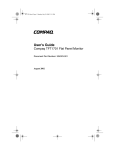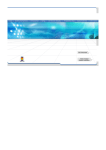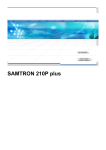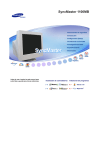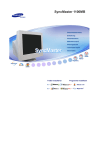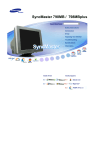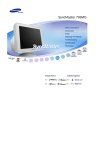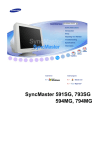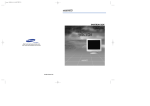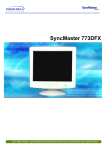Download HP P930 User's Manual
Transcript
P930.book Page i Monday, September 9, 2002 12:20 PM User’s Guide P930 Monitor Document Part Number: 305776-001 September 2002 P930.book Page ii Monday, September 9, 2002 12:20 PM © 2002 Hewlett-Packard Company Microsoft, MS-DOS, Windows, Windows NT are trademarks of Microsoft Corporation in the U.S. and other countries. All other product names mentioned herein may be trademarks of their respective companies. Hewlett-Packard Company shall not be liable for technical or editorial errors or omissions contained herein or for incidental or consequential damages in connection with the furnishing, performance, or use of this material. The information in this document is provided “as is” without warranty of any kind, including, but not limited to, the implied warranties of merchantability and fitness for a particular purpose, and is subject to change without notice. The warranties for HP products are set forth in the express limited warranty statements accompanying such products. Nothing herein should be construed as constituting an additional warranty. This document contains proprietary information that is protected by copyright. No part of this document may be photocopied, reproduced, or translated to another language without the prior written consent of Hewlett-Packard Company. Å WARNING: Text set off in this manner indicates that failure to follow directions could result in bodily harm or loss of life. Ä CAUTION: Text set off in this manner indicates that failure to follow directions could result in damage to equipment or loss of information. User’s Guide P930 Monitorr First Edition September 2002 Document Part Number: 305776-001 P930.book Page iii Monday, September 9, 2002 12:20 PM Contents 1 Product Features 2 Safety and Maintenance Guidelines Important safety information . . . . . . . . . . . . . . . . . . . . . . 2–1 Maintenance guidelines . . . . . . . . . . . . . . . . . . . . . . . . . . 2–2 3 Setting Up the Monitor Attaching and removing the base. . . . . . . . . . . . . . . . . . . 3–1 Connecting the monitor . . . . . . . . . . . . . . . . . . . . . . . . . . 3–3 4 Operating the Monitor Installing information files. . . . . . . . . . . . . . . . . . . . . . . . 4–1 Front panel components . . . . . . . . . . . . . . . . . . . . . . . . . . 4–2 Rear components . . . . . . . . . . . . . . . . . . . . . . . . . . . . . . . 4–4 Using the on-screen display . . . . . . . . . . . . . . . . . . . . . . . 4–5 Viewing the OSD menu. . . . . . . . . . . . . . . . . . . . . . . 4–6 Monitor messages. . . . . . . . . . . . . . . . . . . . . . . . . . . . . . 4–16 Energy saver feature. . . . . . . . . . . . . . . . . . . . . . . . . . . . 4–16 User modes. . . . . . . . . . . . . . . . . . . . . . . . . . . . . . . . . . . 4–17 A Troubleshooting Solving common problems . . . . . . . . . . . . . . . . . . . . . . . A–1 Using the worldwide Web . . . . . . . . . . . . . . . . . . . . . . . . A–2 Preparing to call technical support. . . . . . . . . . . . . . . . . . A–3 User’s Guide iii P930.book Page iv Monday, September 9, 2002 12:20 PM B Technical Specifications P930 Monitor . . . . . . . . . . . . . . . . . . . . . . . . . . . . . . . . . . B–1 Display Resolutions . . . . . . . . . . . . . . . . . . . . . . . . . . . . . B–3 C Agency Regulatory Notices Federal Communications Commission Notice. . . . . . . . . Modifications. . . . . . . . . . . . . . . . . . . . . . . . . . . . . . . Cables . . . . . . . . . . . . . . . . . . . . . . . . . . . . . . . . . . . . Declaration of Conformity for Products Marked with FCC Logo, United States Only . . . . . . Canadian Notice . . . . . . . . . . . . . . . . . . . . . . . . . . . . Avis Canadien . . . . . . . . . . . . . . . . . . . . . . . . . . . . . . European Union Notice . . . . . . . . . . . . . . . . . . . . . . . Japanese Notice . . . . . . . . . . . . . . . . . . . . . . . . . . . . . EPA Energy Star Compliance . . . . . . . . . . . . . . . . . . Power Cord Set Requirements. . . . . . . . . . . . . . . . . . C–1 C–2 C–2 C–2 C–3 C–3 C–3 C–3 C–4 C–4 D TCO ‘99 Requirements Environmental Requirements. . . . . . . . . . . . . . . . . . . . . . D–3 Flame Retardants . . . . . . . . . . . . . . . . . . . . . . . . . . . . D–3 Cadmium . . . . . . . . . . . . . . . . . . . . . . . . . . . . . . . . . . D–4 Mercury . . . . . . . . . . . . . . . . . . . . . . . . . . . . . . . . . . . D–4 CFCs (Freons) . . . . . . . . . . . . . . . . . . . . . . . . . . . . . . D–5 Lead . . . . . . . . . . . . . . . . . . . . . . . . . . . . . . . . . . . . . . D–5 iv User’s Guide P930.book Page 1 Monday, September 9, 2002 12:20 PM 1 Product Features Your color monitor is an easy to use microprocessor-based, digitally controlled, high performance product. The monitor features include: ■ 18-inch (45.7 cm) viewable area display. ■ 1600 dots and 1200 lines flicker free display resolution. ■ Built-in pedestal that allows monitor tilt and swivel. ■ Plug and play capability if supported by your system. ■ On-Screen Display (OSD) adjustments in ten different languages: English, French, German, Italian, Swedish and Spanish, Portuguese, Russian, Polish and Magyar for ease of set-up and screen optimization. ■ Software and Reference Library CD that comes with your monitor includes an information file (INF) and Image Color Matching file (ICM) software. ■ Energy Saver feature for Energy Star compliance. ■ Compliant with the following regulated specifications: User’s Guide ❏ EPA ENERGY STAR ❏ European Union CE Directives (on select models) ❏ Swedish MPR II 1990 ❏ Swedish TCO '99 1–1 P930.book Page 1 Monday, September 9, 2002 12:20 PM 2 Safety and Maintenance Guidelines Important safety information A power cord is included with your monitor. If another cord is used, use only a power source and connection appropriate for this monitor. For information on the correct power cord set to use with your monitor, refer to the “Power Cord Set Requirements” section in Appendix C. Å WARNING: To reduce the risk of electric shock or damage to your equipment, do not disable the power cord grounding feature. This equipment is designed to be connected to a grounded (earthed) power outlet that is easily accessible to the operator. The grounding plug is an important safety feature. Å WARNING: For your safety, be sure that the power outlet you plug the power cord into is easily accessible and located as close to the equipment as possible. When you need to disconnect the power to the equipment, unplug the power cord from the power outlet by grasping the plug firmly. Never pull on the cord. User’s Guide 2–1 P930.book Page 2 Monday, September 9, 2002 12:20 PM Safety and Maintenance Guidelines Ä CAUTION: For the protection of your monitor, as well as your computer, connect all power cords for your computer and its peripheral devices (such as a monitor, printer, scanner) to some form of surge protection device such as a power strip or Uninterruptible Power Supply (UPS). Not all power strips provide surge protection; the power strips must be specifically labeled as having this ability. Use a power strip whose manufacturer offers a Damage Replacement Policy so you can replace your equipment if surge protection fails. Maintenance guidelines To enhance the performance and extend the life of your monitor: 2–2 ■ Do not open your monitor cabinet or attempt to service this product yourself. Adjust only those controls that are covered in the operating instructions. If your monitor is not operating properly or has been dropped or damaged, contact your HP authorized dealer, reseller, or service provider. ■ Adjust only those controls that are discussed in the operating instructions. ■ Place your monitor at least 3 inches (76 mm) away from walls or other enclosures. ■ Use only a power source and connection appropriate for this monitor, as indicated on the label/back plate of the monitor. ■ Be sure the total ampere rating of the products connected to the outlet does not exceed the current rating of the electrical outlet, and the total ampere rating of the products connected to the cord does not exceed the rating of the cord. Look on the power label to determine the ampere rating (AMPS or A) for each device. ■ Install your monitor near an outlet that you can easily reach. Disconnect the monitor by grasping the plug firmly and pulling it from the outlet. Never disconnect the monitor by pulling the cord. User’s Guide P930.book Page 3 Monday, September 9, 2002 12:20 PM Safety and Maintenance Guidelines Ä ■ Turn your monitor off when not in use. You can substantially increase the life expectancy of your monitor by using a screen saver program and turning off the monitor when not in use. ■ Unplug your monitor from the wall outlet before cleaning. Do not use liquid cleaners or aerosol cleaners. Use a damp cloth for cleaning. If the screen requires additional cleaning, use an antistatic screen cleaner. CAUTION: Do not use benzene, thinner, ammonia, or any other volatile substances to clean your monitor or the screen. These chemicals may damage the cabinet finish as well as the screen. ■ Slots and openings in the cabinet are provided for ventilation. These openings must not be blocked or covered. Never push objects of any kind into cabinet slots or other openings. ■ Do not place plants on top of your monitor. Water or dirt from the plant may get into the vents. ■ Do not drop your monitor or place it on an unstable surface. ■ Do not allow anything to rest on the power cord. Do not walk on the cord. ■ Keep your monitor in a well-ventilated area, away from excessive light, heat or moisture. Keep your monitor away from high-capacity transformers, electric motors, and other devices with strong magnetic fields. ■ In a two-monitor system, place your monitors as far apart from one another as possible to lessen interference between them. ■ Do not place the monitor face down. Damage could result to the front panel controls or the monitor screen. User’s Guide 2–3 P930.book Page 1 Monday, September 9, 2002 12:20 PM 3 Setting Up the Monitor Before setting up the monitor, ensure that power is turned off to the monitor, computer system, and other attached devices. Attaching and removing the base On some monitors, the base must be attached prior to setting up the monitor. To attach the base: 1. Place the monitor bottom side up on a flat work surface. 2. Align the tabs on the base with the corresponding slots on the bottom of the monitor. 3. Press the base onto the monitor until the tabs are fully engaged in the slots. 4. Push the base toward the front of the monitor until the release latch clicks into the locked position. Ä CAUTION: Do not bend the snap. User’s Guide 3–1 P930.book Page 2 Monday, September 9, 2002 12:20 PM Setting Up the Monitor ✎ The base will align with the monitor slots in only one position. To remove the base: 1. Please the monitor bottom side up on a flat work surface. 2. Squeeze and pull up on the release latch on the base. 3. Push the base toward the back of the monitor and lift up to remove the base. 3–2 User’s Guide P930.book Page 3 Monday, September 9, 2002 12:20 PM Setting Up the Monitor Connecting the monitor To connect the monitor to the computer system: 1. Place the monitor in a convenient, well ventilated location near your computer. 2. Connect the power cord for your monitor to the power port on the back of the monitor. Plug the power cord for the monitor into a nearby electrical outlet. 3. Connect the monitor signal cable to your computer’s video port, video board, video card or graphics card. 4. Connect the computer’s power cord to an electrical outlet. 5. Turn on your computer and monitor. If you monitor displays an image, installation is complete. User’s Guide 3–3 P930.book Page 4 Monday, September 9, 2002 12:20 PM Setting Up the Monitor Å WARNING: To reduce the risk of electric shock or damage to your equipment: ■ Do not disable the power cord grounding plug. The grounding plug is an important safety feature. ■ Plug the power cord into a grounded (earthed) electrical outlet that is easily accessible at all times. ■ Disconnect power from the monitor by unplugging the power cord from the electrical outlet. ■ Do not place anything on power cords or cables. Arrange them so that no one may accidentally step on or trip over them. Do not pull on a cord or cable. When unplugging from the electrical outlet, grasp the cord by the plug. you turn on the monitor and computer equipment, refer to ✎ After “Installing Information Files” in chapter 4 to install the software contained on the CD that is included with your monitor. Use the on-screen instructions to adjust the picture quality of your monitor. Always activate a screen saver program or turn off the monitor when it is not in use for a prolonged period of time. 3–4 User’s Guide P930.book Page 1 Monday, September 9, 2002 12:20 PM 4 Operating the Monitor Installing information files The Software and Reference Library CD-ROM included with your monitor contains two information files to be installed onto your computer; an .INF file and an .ICM file. The .INF file defines monitor resources and provides specifications used by most operating systems to install support software for certain hardware devices. The .INF file ensures monitor compatibility and optimization with your computer’s graphics adapter. The .INF files are also downloadable from the Internet by clicking on www.hp.com/go/support and selecting your monitor model. The .ICM file provides color matching consistency from monitor screen to printer and is activated from within graphics programs that have this feature. To install these files on your computer: 1. Insert the Software and Reference Library CD-ROM in your computer's optical drive. 2. When the CD-ROM menu launches, select Install INF and ICM Files and follow the on-screen instructions. .INF and .ICM files, download them from the HP ✎ ToWebgetsitetheatlatest www.hp.com/go/support, then select your monitor model to download the appropriate files. User’s Guide 4–1 P930.book Page 2 Monday, September 9, 2002 12:20 PM Operating the Monitor Front panel components 4–2 No. Component Function 1 Information button Displays information about your monitor, such as model name, vertical and horizontal frequencies and the serial number. 2 Exit button Use to close the active menu or the On-screen display (OSD) menu. User’s Guide P930.book Page 3 Monday, September 9, 2002 12:20 PM Operating the Monitor No. Component Function 3 Adjust buttons Allows you to highlight and adjust items in the menu. 4 Menu button Use to open the OSD and activate a highlighted menu item. 5 Power indicator Illuminates green during normal operation and blinks green when the monitor is in sleep mode. 6 Power button Use to turn the monitor on and off. For energy conservation, turn your monitor off when it is not needed or when leaving it unattended for long periods. Refer to your computer manual for instructions on setting energy saver features (sometimes called power management features). User’s Guide 4–3 P930.book Page 4 Monday, September 9, 2002 12:20 PM Operating the Monitor Rear components 4–4 No. Component Function 1 Power port connector Connects the monitor power cord. 2 Signal cable Connects to the computer’s video video port, video board, video card or graphics card. 3 Tilt/Swivel Base Can be removed from the monitor. User’s Guide P930.book Page 5 Monday, September 9, 2002 12:20 PM Operating the Monitor Using the on-screen display No. Button Function 1 Information Displays information about your monitor, such as model name, vertical and horizontal frequencies and the serial number. 2 Exit Closes the active menu or OSD. 3 Adjust Highlights and adjust items using the OSD. 4 Menu Opens the OSD and activates a highlighted menu item. User’s Guide 4–5 P930.book Page 6 Monday, September 9, 2002 12:20 PM Operating the Monitor The On-Screen Display (OSD) adjusts the screen image based on your viewing preferences. To access the OSD: 1. Press the Power button to turn on the monitor, if the monitor is not already on. 2. Press the Menu button to open the On-Screen Display menu. 3. To move to a menu screen, press the Adjust buttons until the menu is highlighted. 4. When your menu screen is displayed, press the Adjust buttons - left arrow, right arrow, up arrow, or down arrow - to adjust or change your preferred OSD setting. 5. Press the Exit button to close the active menu or OSD. 4–6 User’s Guide P930.book Page 7 Monday, September 9, 2002 12:20 PM Operating the Monitor Viewing the OSD menu Your OSD menu has the following feature settings: Menu Information User’s Guide Function Provides information on monitor model name, vertical and horizontal frequencies, and serial number. You may need to provide the monitor serial number to support technicians when calling customer support. This screen can not be adjusted. 4–7 P930.book Page 8 Monday, September 9, 2002 12:20 PM Operating the Monitor Menu Brightness/Contrast 4–8 Function Continued Adjusts the screen brightness and contrast. User’s Guide P930.book Page 9 Monday, September 9, 2002 12:20 PM Operating the Monitor Menu Control Lock User’s Guide Function Continued Allows you to lock or unlock the OSD. To lock or unlock the OSD, press the menu button for 10 seconds. 4–9 P930.book Page 10 Monday, September 9, 2002 12:20 PM Operating the Monitor Menu Position/Size Function Continued • Select Position to change the vertical or horizontal position of the monitor’s entire viewing area. • Select Size to change the vertical or horizontal size of the monitor’s entire viewing area. • Select Zoom to get a close-up or a longshot view of the monitor’s viewing area. You can decrease or enlarge the screen viewing area. 4–10 User’s Guide P930.book Page 11 Monday, September 9, 2002 12:20 PM Operating the Monitor Menu Geometry Function Continued • Select Parallel/Rotation to adjust the parallelogram setting when the display is leaning left or right, or adjust the rotation setting when the entire dipslay is tilted left or right. • Select Pincushion/Trapezoid to adjust the pincushion setting when the sides of the display are bowed in or bowed out, or adjust the trapezoid setting when the top or bottom of the display is too large or small. • Select Pinbalance to adjust the settings when the sides of the display are bowed towards the left or right. • Select Sidepin to adjust the sidepin corner correction when the sides of the display are bowed in or bowed out, or when the top or bottom of the display is too large or small. • Select the Pinbalance Corner correction when the sides of the display are bowed in or bowed out, or when the top or bottom of the display is too large or small. User’s Guide 4–11 P930.book Page 12 Monday, September 9, 2002 12:20 PM Operating the Monitor Menu Color Function Continued Use to select Color 1, Color 2, or Color 3 to change the color temperature and adjust individual red, green and blue color control. Color temperature is a measure of the “warmth” of the image colors. The available range is between 5000 to 9300K. ✎ 4–12 If you select recall to reset your monitor setting, the Color settings will not reset. User’s Guide P930.book Page 13 Monday, September 9, 2002 12:20 PM Operating the Monitor Menu Screen Function Continued • Select Clear Moire when a moire pattern, which looks like a series of concentric circles or arcs, appears on your screen. • Select Linearity to adjust the settings when the display image is compressed at the left, right or top, bottom. • Select Focus when the image displayed on the screen is not sharp in all areas. • Select Convergence to adjust the horizontal or vertical convergence to properly align the color dots that make up the image. Convergence affects picture clarity. User’s Guide 4–13 P930.book Page 14 Monday, September 9, 2002 12:20 PM Operating the Monitor Menu Advanced Function Continued • Select Degauss to remove color impurities caused by magnetic fields. Do not use the degauss feature more than once within a 30 minute period. ✎ After using the degauss feature, the monitor may buzz momentarily, the image colors may change and the image will jiggle for a few seconds. These effects are normal. • Select Recall to reset the monitor settings to their original levels. ✎ If you press Yes to reset the monitor, the position, size, pincushion, trapezoid, parallelogram, pinbalance, rotation, and clear moire settings will be reset. All other settings will remain the same. • Select Video Input Level to set the level to 1.0 V for video cards that use video signals higher than 1.0 V, which causes the display to be very bright. 4–14 User’s Guide P930.book Page 15 Monday, September 9, 2002 12:20 PM Operating the Monitor Menu Menu Function Continued • Select Display Timing to see the frequency (user control mode), the polarity of the operational signals, the default frequency set by the manufacturer, and the resolution level of your monitor. ✎ These screens do not allow any changes to the settings. They are for information only. • Select Menu Position to change the position of where the OSD menu appears on your monitor. • Select Menu Duration to set the amount of time the menu will wait before it automatically turns off if no adjustments. • Select Languages to choose from one of ten languages: English, German, French, Italian, Portuguese, Spanish, Swedish, Russian, Polish or Magyar. Some languages may not appear in some regions. ✎ User’s Guide The language chosen affects only the language of the OSD. It has no affect on any software running on the computer. 4–15 P930.book Page 16 Monday, September 9, 2002 12:20 PM Operating the Monitor Monitor messages Special messages will appear on the monitor screen to identify the following monitor conditions: ■ Video mode not supported - If there is something wrong with the input signal, a message appears on the screen or the screen goes blank although the power indicator light is still on. This message indicates the monitor is out of scan range or that you need to check the signal cable. ■ No Connection, check signal cable - Indicates the video cable may not be plugged into the computer or the computer may not be turned on. Energy saver feature When the monitor is in its normal operating mode, the monitor uses 120 watts maximum of power and the Power light is green. The monitor also supports a reduced power state. The reduced power state will be entered into if the monitor detects the absence of either the horizontal sync signal and/or the vertical sync signal. Upon detecting the absence of these signals, the monitor screen is blanked and the power light flashes green. When the monitor is in the reduced power state, the monitor will use 3 watts maximum of power. There is a brief warm up period before the monitor will return to its normal operating mode. Refer to your computer manual for instructions on setting energy saver features (sometimes called power management features). above energy saver feature only works when connected to ✎ The computers that have energy saver features. 4–16 User’s Guide P930.book Page 17 Monday, September 9, 2002 12:20 PM Operating the Monitor User modes The video controller signal may occasionally call for a mode that is not preset and preload mode if: ■ You are not using a Compaq standard graphics adapter. ■ You are not using preset and preload modes. If this occurs, you may need to readjust the parameters of the monitor screen by using the on-screen display. User changes can be made to any or all of these modes and saved in memory. The monitor automatically stores the new setting, then recognizes the new mode just as it does the preset and preload modes. In addition to the 10 factory preset and preload modes, there are 10 user modes that can be entered and stored. User’s Guide 4–17 P930.book Page 1 Monday, September 9, 2002 12:20 PM A Troubleshooting Solving common problems The following table lists possible problems, the possible cause of each problem, and the recommended solutions. Problem Possible Cause Solution Screen is blank. Power cord is disconnected. Connect the power cord. Power switch is off. Turn on power. Video cable is improperly connected. Connect video cable properly. Screen blanking utility is active. Depress any key on the keyboard or move the mouse. Brightness and contrast are too low. Press one of the Adjust buttons to access the brightness/contrast OSD menu. Adjust the screen as needed. Image appears blurred, indistinct, or too dark. User’s Guide A–1 P930.book Page 2 Monday, September 9, 2002 12:20 PM Troubleshooting Problem Possible Cause Solution Image is not centered. Position may need adjustment. Press the Menu button to access the OSD menu. Select Position/Size to adjust the horizontal or vertical position of the image. “No Connection, Check Signal Cable” is displayed on screen. Monitor video cable is disconnected. Connect the 15-pin monitor video cable to the computer. Be sure that the computer power is on. “Sync. Out of Range, 68.77kHz 168Hz PP” is displayed on screen. Video resolution and/or refresh rate are set higher than what your monitor supports. Restart your computer and enter Safe Mode. Change your settings to a supported setting (see “Technical Specifications”). Restart your computer so that the new settings take effect. Monitor is overheating. There is not enough air space to allow proper ventilation. Leave at least 3 inches (76 mm) of ventilation space around the monitor. Using the worldwide Web Before contacting customer services, refer to the support web site at: http://www.hp.com/go/support A–2 User’s Guide P930.book Page 3 Monday, September 9, 2002 12:20 PM Troubleshooting Preparing to call technical support If you cannot solve a problem using the troubleshooting tips in this section, you may need to call technical support. Have the following information available when you call: ■ The monitor ■ Monitor model number ■ Serial number for the monitor ■ Purchase date on invoice ■ Conditions under which the problem occurred ■ Error messages received ■ Hardware configuration ■ Hardware and software you are using User’s Guide A–3 P930.book Page 1 Monday, September 9, 2002 12:20 PM B Technical Specifications P930 Monitor Technical Specifications Display Type 19 inches Natural Flat 48 cm Viewable Image Size 18.0 inch diagonal 45.7 cm Face Treatment Aluminized tri-color phosphor dot trio with black matrix. Anti-doming invar shadow mask. Multilayer coated with anti-static. Maximum Weight (Unpacked) 55.11 lbs 25.0 kg Dimensions (with stand) Height Depth Width 19.3 in 18.6 in 18.4 in 490.7 mm 472.8 mm 469 mm Maximum Graphics Resolution 1920 x 1440, 60Hz Screen Pitch 0.24 mm Dot Pitch 0.25 mm (Horizontal) Horizontal Frequency 30 to 110 kHz User’s Guide B–1 P930.book Page 2 Monday, September 9, 2002 12:20 PM Technical Specifications Technical Specifications Continued Vertical Frequency 50 to 160 Hz Environmental Requirements Temperature (Independent of Altitude) Operating Temperature Storage Temperature 32 to 104 o F -04 to +113 o F Humidity (Noncondensing) Operating Nonoperating 10 to 80% 5 to 95% Power Source 100 - 240 VAC, 50/60 +/-3 Hz Power Consumption 120 watts Input Terminals 15-pin D-type cable B–2 0 to 40 o C -20 to +45 o C User’s Guide P930.book Page 3 Monday, September 9, 2002 12:20 PM Technical Specifications Display Resolutions The display resolutions listed below are the most commonly used modes and are set as factory defaults. This monitor automatically recognizes these preset and preload modes and they will appear properly sized and centered on the screen. Factory Preset and Preload Display Modes Horz Polarity Vert Freq (Hz) Vert Polarity Pixel Clk (MHz) Source - 25.175 VGA 36.00 VESA Mode Pixel Format Horz Freq (kHz) 1 640 x 480 31.47 - 60.0 2 640 x 480 43.27 - 85.0 3 720 x 400 31.47 - 70.0 + 28.322 VGA 4* 800 x 600 53.67 + 85.0 + 56.25 VESA 5* 1024 x 786 68.68 + 84.99 + 94.50 VESA 6 1280 x 1024 79.98 + 75.0 + 135.00 VESA 7* 1280 x 1024 91.15 + 85.0 157.50 VESA 8 1600 x 1200 93.750 + 75.000 + 202.50 VESA 9* 1600 x 1200 106.25 + 85.0 + 229.50 VESA 10 1920 x 1440 90.00 _ 60.0 234.00 VESA Primary * Indicates preset timing mode. User’s Guide B–3 P930.book Page 1 Monday, September 9, 2002 12:20 PM C Agency Regulatory Notices Federal Communications Commission Notice This equipment has been tested and found to comply with the limits for a Class B digital device, pursuant to Part 15 of the FCC Rules. These limits are designed to provide reasonable protection against harmful interference in a residential installation. This equipment generates, uses, and can radiate radio frequency energy and, if not installed and used in accordance with the instructions, may cause harmful interference to radio communications. However, there is no guarantee that interference will not occur in a particular installation. If this equipment does cause harmful interference to radio or television reception, which can be determined by turning the equipment off and on, the user is encouraged to try to correct the interference by one or more of the following measures: ■ Reorient or relocate the receiving antenna. ■ Increase the separation between the equipment and the receiver. ■ Connect the equipment into an outlet on a circuit different from that to which the receiver is connected. ■ Consult the dealer or an experienced radio or television technician for help. User’s Guide C–1 P930.book Page 2 Monday, September 9, 2002 12:20 PM Agency Regulatory Notices Modifications The FCC requires the user to be notified that any changes or modifications made to this device that are not expressly approved by Hewlett-Packard Company may void the user's authority to operate the equipment. Cables Connections to this device must be made with shielded cables with metallic RFI/EMI connector hoods to maintain compliance with FCC Rules and Regulations. Declaration of Conformity for Products Marked with FCC Logo, United States Only This device complies with Part 15 of the FCC Rules. Operation is subject to the following two conditions: (1) this device may not cause harmful interference, and (2) this device must accept any interference received, including interference that may cause undesired operation. For questions regarding your product, contact: Hewlett-Packard Company P. O. Box 692000, Mail Stop 530113 Houston, Texas 77269-2000 Or, call 1-800- 652-6672 For questions regarding this FCC declaration, contact: Hewlett-Packard Company P. O. Box 692000, Mail Stop 510101 Houston, Texas 77269-2000 Or, call (281) 514-3333 To identify this product, refer to the Part, Series, or Model number found on the product. C–2 User’s Guide P930.book Page 3 Monday, September 9, 2002 12:20 PM Agency Regulatory Notices Canadian Notice This Class B digital apparatus meets all requirements of the Canadian Interference-Causing Equipment Regulations. Avis Canadien Cet appareil numérique de la classe B respecte toutes les exigences du Règlement sur le matériel brouilleur du Canada. European Union Notice Products with the CE Marking comply with both the EMC Directive (89/336/EEC) and the Low Voltage Directive (73/23/EEC) issued by the Commission of the European Community. Compliance with these directives implies conformity to the following European norms (in brackets are the equivalent international standards): ■ EN55022 (CISPR 22) - Electromagnetic Interference ■ EN55024 (IEC61000-4-2,3,4,5,6,8,11) - Electromagnetic Immunity ■ EN61000-3-2 (IEC61000-3-2) - Power Line Harmonics ■ EN61000-3-3 (IEC61000-3-3) - Power Line Flicker ■ EN60950 (IEC950) - Product Safety Japanese Notice User’s Guide C–3 P930.book Page 4 Monday, September 9, 2002 12:20 PM Agency Regulatory Notices EPA Energy Star Compliance Monitors that are marked with the Energy Star Logo meet the requirements of the EPA Energy Star program. As an Energy Star Partner, Hewlett-Packard Company has determined that this product meets the Energy Star guidelines for energy efficiency. Specific details on using the Energy Saving features can be found in the energy saver or power management section of the computer manual. Power Cord Set Requirements The monitor power supply is provided with Automatic Line Switching (ALS). This feature allows the monitor to operate on input voltages between 100-120V or 200-240V. The power cord set (flexible cord or wall plug) received with the monitor meets the requirements for use in the country where you purchased the equipment. If you need to obtain a power cord for a different country, you should purchase a power cord that is approved for use in that country. The power cord must be rated for the product and for the voltage and current marked on the product's electrical ratings label. The voltage and current rating of the cord should be greater than the voltage and current rating marked on the product. In addition, the cross-sectional area of the wire must be a minimum of 0.75 mm² or 18AWG, and the length of the cord must be between 6 feet (1.8 m) and 12 feet (3.6 m). If you have questions about the type of power cord to use, contact your HP authorized service provider. A power cord should be routed so that it is not likely to be walked on or pinched by items placed upon it or against it. Particular attention should be paid to the plug, electrical outlet, and the point where the cord exits from the product. C–4 User’s Guide P930.book Page 1 Monday, September 9, 2002 12:20 PM D TCO ‘99 Requirements You have just purchased a TCO'99 approved and labelled product! Your choice has provided you with a product developed for professional use. Your purchase has also contributed to reducing the burden on the environment and also to the further development of environmentally adapted electronics products. Why do we have environmentally labelled computers? In many countries, environmental labelling has become an established method for encouraging the adaptation of goods and services to the environment. The main problem, as far as computers and other electronics equipment are concerned, is that environmentally harmful substances are used both in the products and during their manufacture. Since it is not so far possible to satisfactorily recycle the majority of electronics equipment, most of these potentially damaging substances sooner or later enter nature. User’s Guide D–1 P930.book Page 2 Monday, September 9, 2002 12:20 PM TCO ‘99 Requirements There are also other characteristics of a computer, such as energy consumption levels, that are important from the viewpoints of both the work (internal) and natural (external) environments. Since all methods of electricity generation have a negative effect on the environment (e.g. acidic and climate-influencing emissions, radioactive waste), it is vital to save energy. Electronics equipment in offices is often left running continuously and thereby consumes a lot of energy. What does labelling involve? This product meets the requirements for the TCO'99 scheme which provides for international and environmental labelling of personal computers. The labelling scheme was developed as a joint effort by the TCO (The Swedish Confederation of Professional Employees), Svenska Naturskyddsforeningen (The Swedish Society for Nature Conservation) and Statens Energimyndighet (The Swedish National Energy Administration). Approval requirements cover a wide range of issues: environment, ergonomics, usability, emission of electric and magnetic fields, energy consumption and electrical and fire safety. The environmental demands impose restrictions on the presence and use of heavy metals, brominated and chlorinated flame retardants, CFCs (freons) and chlorinated solvents, among other things. The product must be prepared for recycling and the manufacturer is obliged to have an environmental policy which must be adhered to in each country where the company implements its operational policy. The energy requirements include a demand that the computer and/or display, after a certain period of inactivity, shall reduce its power consumption to a lower level in one or more stages. The length of time to reactivate the computer shall be reasonable for the user. D–2 User’s Guide P930.book Page 3 Monday, September 9, 2002 12:20 PM TCO ‘99 Requirements Labelled products must meet strict environmental demands, for example, in respect of the reduction of electric and magnetic fields, physical and visual ergonomics and good usability. Below you will find a brief summary of the environmental requirements met by this product. The complete environmental criteria document may be ordered from: TCO Development SE-114 94 Stockholm, Sweden Fax: +46 8 782 92 07 Email (Internet): [email protected] Current information regarding TCO'99 approved and labelled products may also be obtained via the Internet, using the address: http://www.tco-info.com/ Environmental Requirements Flame Retardants Flame retardants are present in printed circuit boards, cables, wires, casings and housings. Their purpose is to prevent, or at least to delay the spread of fire. Up to 30% of the plastic in a computer casing can consist of flame retardant substances. Most flame retardants contain bromine or chloride, and those flame retardants are chemically related to another group of environmental toxins, PCBs. Both the flame retardants containing bromine or chloride and the PCBs are suspected of giving rise to severe health effects, including reproductive damage in fish-eating birds and mammals, due to the bioaccumulative* processes. Flame retardants have been found in human blood and researchers fear that disturbances in foetus development may occur. User’s Guide D–3 P930.book Page 4 Monday, September 9, 2002 12:20 PM TCO ‘99 Requirements The relevant TCO'99 demand requires that plastic components weighing more than 25 grams must not contain flame retardants with organically bound bromine or chlorine. Flame retardants are allowed in the printed circuit boards since no substitutes are available. is defined as substances which accumulate ✎ Bioaccumulative within living organisms. Cadmium Cadmium is present in rechargeable batteries and in the colour-generating layers of certain computer displays. Cadmium damages the nervous system and is toxic in high doses. The relevant TCO'99 requirement states that batteries, the colour-generating layers of display screens and the electrical or electronics components must not contain any cadmium. ✎ Cadmium is a heavy metal that is Bioaccumulative. Mercury Mercury is sometimes found in batteries, relays and switches. It damages the nervous system and is toxic in high doses. The relevant TCO'99 requirement states that batteries may not contain any mercury. It also demands that mercury is not present in any of the electrical or electronics components associated with the labelled unit. There is however one exception. Mercury is, for the time being, permitted in the back light system of flat panel monitors as there today is no commercially available alternative. TCO aims on removing this exception when a mercury free alternative is available. ✎Mercury is a heavy metal that is Bioaccumulative. D–4 User’s Guide P930.book Page 5 Monday, September 9, 2002 12:20 PM TCO ‘99 Requirements CFCs (Freons) The relevant TCO'99 requirement states that neither CFCs nor HCFCs may be used during the manufacture and assembly of the product. CFCs (freons) are sometimes used for washing printed circuit boards. CFCs break down ozone and thereby damage the ozone layer in the stratosphere, causing increased reception on earth of ultraviolet light with e.g. increased risks of skin cancer (malignant melanoma) as a consequence. Lead Lead can be found in picture tubes, display screens, solders and capacitors. Lead damages the nervous system and in higher doses, causes lead poisoning. The relevant TCO´99 requirement permits the inclusion of lead since no replacement has yet been developed. ✎Lead is a heavy metal that is Bioaccumulative. User’s Guide D–5












































